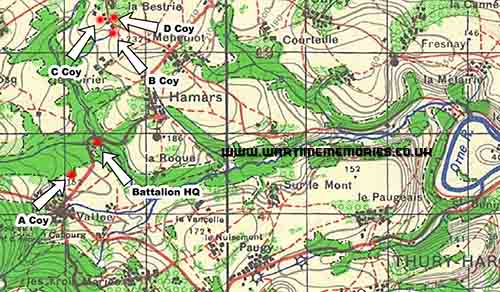CSM. William Charles Stanton
British Army 2/6th Btn. South Staffordshire Regiment
from:Walsall
(d.6th Aug 1944)
Our family does not know much about Bill Stanton, well his time in the Army anyway. Family deaths have broken the family up, and the elders that knew our family history and about Bill have all passed on. So all we really have is his War Graves Certificate. My mother remembers her mom always saying it was her Uncle Bill who chose her name for her. He always said, "if it's a girl, call her Yvonne". My great uncle Bill died 6th of August 1944 and my mom was born the following week.
A kind gentleman, Adrian Andrews, offered some information on Bill as follows: Your great uncle with the 2nd/6th South Staffs at the time when he was killed. Prior to August, the 59th Division was engaged as a part of Operation Pomegranate (16th-18th July) attempting to take the fortified village of Noyers Bocage. 2/6th Battalion, as part of 177 Brigade, was much involved in the fighting that occurred there.
In the first week of August the Division advanced towards the River Orne. The plan was to force a crossing and to form a bridgehead over the river at a place called Grimbosq. 176 Brigade of the 59th was to form and hold this bridgehead, whilst 177 Brigade moved further south in order to take the high ground that overlooked the river and the major town of Thury Harcourt. The Brigade advanced from the area of Noyers Bocage and on the 6th August, the fateful day for your great uncle, the 2nd/6th were in the area of La Roque. This location was roughly at the start of a series of ridges that approached the river. Each of these ridges as you move towards the banks of the Orne become successively higher and are therefore rather hard to overcome in a military sense. The British were often in full view of the enemy who also had the great advantage of being above the attackers. To take this high ground would gain control over the area and give access to the all important road that runs through Thury Harcourt in the direction of Falaise, which was where the German 7th Army and 5th Panzer Army were destroyed (in the infamous Falaise Pocket).
La Roque was the objective of 1st/6th South Staffs and the 2nd/6th South Staffs were in the area. I have attached a map of the area with the locations of A, B, C and D Companies of 2nd/6th Battalion on the 6th August marked up. The position of the Battalion HQ is also noted. An attack by the Battalion was planned for that day but was put off. The war diary does not say much about casualties sustained on the 6th, however, it is noted that at 8.30 in the evening, a shell landed in the B Company area which resulted in 5 casualties, the CSM Stanton being reported as killed. If your great uncle was in B Company, he may be one of the reported casualties. To put the map in the right perspective, look up Thury Harcourt on Google maps and look for the distinctive loop in the River Orne. This loop is on the right-hand side of the close-up map.
If you go to the cemetery in Fontenay-le-Pesnil (incidentally this is the 59th Divisional Cemetery the majority of plots belong to the men of the South Staffs who fell in the July/August fighting) you must also go to the modest but very poignant museum in Thury Harcourt (the town liberated by the 59th). It has recently been set up in the Old Fire Station to the memory of the men of the 59th (Staffordshire) Division. 50% of the proceeds of my book are to be donated to the museum to help them maintain the collection and to expand the museum into additional rooms as their collection grows.
